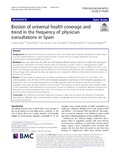Mostrar el registro sencillo del ítem
Erosion of universal health coverage and trend in the frequency of physician consultations in Spain
| dc.creator | Lostao Unzu, Lourdes | es_ES |
| dc.creator | Ronda, Elena | es_ES |
| dc.creator | Pascual, Cruz | es_ES |
| dc.creator | Cea, Lucía | es_ES |
| dc.creator | Moreno Lostao, Almudena | es_ES |
| dc.date.accessioned | 2021-01-20T09:41:13Z | |
| dc.date.available | 2021-01-20T09:41:13Z | |
| dc.date.issued | 2020 | |
| dc.identifier.issn | 1475-9276 (Electronic) | |
| dc.identifier.uri | https://hdl.handle.net/2454/39027 | |
| dc.description.abstract | Background: We studied the frequency of physician visits in the native and immigrant populations in Spain before and after implementation of a governmental measure to restrict the use of public healthcare services by undocumented immigrants beginning in 2012. Methods: Data were taken from the 2009 and 2014 European Health Surveys carried out in Spain. We investigated any physician consultation in the last 4 weeks before the interview, as well as visits to a family physician, public specialist physician and private specialist physician. We estimated the frequency of visits in 2009 and in 2014 in the native and immigrant populations and the difference in the frequency between the two populations, by calculating the percentage ratio estimated by binomial regression and adjusted for different confounders that are indicators of the need for assistance. Results: The percentage of persons who consulted any physician in 2009 and 2014 was 31.7 and 32.9% in the native population, and 25.6 and 30.1% in the immigrant population, respectively. In the immigrant population, the frequency of visits to the general practitioner and public specialist physician increased, whereas in the native population only public specialist physician visits increased. The frequency of private specialist visits remained stable in both populations. After adjusting for the indicators of need for healthcare, no significant differences between the immigrant and native populations were seen in the frequency of visits, except for private specialist consultations, which were less frequent among immigrants. Conclusion: The restriction of universal healthcare coverage in Spain did not reduce the frequency of physician visits between 2009 and 2014, as the frequency of these consultations was seen to increase in both the native and immigrant populations. | en |
| dc.description.sponsorship | This study was supported by a grant from the 'Plan Estatal de I + D', Ministry of Science, Innovation and Universities of Spain (no. CSO2017–83180-P). | en |
| dc.description.sponsorship | This study was supported by a grant from the “Plan Estatal de I + D, Ministry of Science, Innovation and Universities of Spain (no. CSO2017–83180-P). | en |
| dc.format.extent | 8 p. | |
| dc.format.mimetype | application/pdf | en |
| dc.language.iso | eng | en |
| dc.publisher | BioMed Central | en |
| dc.relation.ispartof | International Journal for Equity in Health, 2020, 19:121 | en |
| dc.rights | © The Author(s). 2020 Open Access This article is licensed under a Creative Commons Attribution 4.0 International License, which permits use, sharing, adaptation, distribution and reproduction in any medium or format, as long as you give appropriate credit to the original author(s) and the source, provide a link to the Creative Commons licence, and indicate if changes were made. The images or other third party material in this article are included in the article's Creative Commons licence, unless indicated otherwise in a credit line to the material. If material is not included in the article's Creative Commons licence and your intended use is not permitted by statutory regulation or exceeds the permitted use, you will need to obtain permission directly from the copyright holder. The Creative Commons Public Domain Dedication waiver (http://creativecommons.org/publicdomain/zero/1.0/) applies to the data made available in this article, unless otherwise stated in a credit line to the data. | en |
| dc.rights.uri | http://creativecommons.org/licenses/by/4.0/ | |
| dc.subject | Healthcare services | en |
| dc.subject | Immigrants | en |
| dc.subject | Spain | en |
| dc.title | Erosion of universal health coverage and trend in the frequency of physician consultations in Spain | en |
| dc.type | info:eu-repo/semantics/article | en |
| dc.type | Artículo / Artikulua | es |
| dc.contributor.department | Sociología y Trabajo Social | es_ES |
| dc.contributor.department | Soziologia eta Gizarte Lana | eu |
| dc.contributor.department | Institute for Advanced Social Research - ICOMMUNITAS | es_ES |
| dc.rights.accessRights | info:eu-repo/semantics/openAccess | en |
| dc.rights.accessRights | Acceso abierto / Sarbide irekia | es |
| dc.identifier.doi | 10.1186/s12939-020-01234-z | |
| dc.relation.projectID | info:eu-repo/grantAgreement/AEI/Plan Estatal de Investigación Científica y Técnica y de Innovación 2013-2016/CSO2017-83180-P/ES/ | en |
| dc.relation.publisherversion | https://doi.org/10.1186/s12939-020-01234-z | |
| dc.type.version | info:eu-repo/semantics/publishedVersion | en |
| dc.type.version | Versión publicada / Argitaratu den bertsioa | es |
Ficheros en el ítem
Este ítem aparece en la(s) siguiente(s) colección(ones)
La licencia del ítem se describe como © The Author(s). 2020 Open Access This article is licensed under a Creative Commons Attribution 4.0 International License,
which permits use, sharing, adaptation, distribution and reproduction in any medium or format, as long as you give
appropriate credit to the original author(s) and the source, provide a link to the Creative Commons licence, and indicate if
changes were made. The images or other third party material in this article are included in the article's Creative Commons
licence, unless indicated otherwise in a credit line to the material. If material is not included in the article's Creative Commons
licence and your intended use is not permitted by statutory regulation or exceeds the permitted use, you will need to obtain
permission directly from the copyright holder. The Creative Commons Public Domain Dedication waiver (http://creativecommons.org/publicdomain/zero/1.0/) applies to the
data made available in this article, unless otherwise stated in a credit line to the data.



